|
|
|
Bentzi Tiram
|
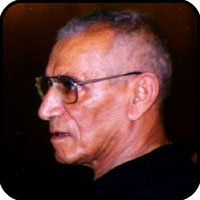 During his career as a choreographer Bentzi Tiram created over 80 dances, including Al Sadenu, Ba'ah Menuchah, Bet Avi, Bo Elai, Debka Ud, Emek Sheli, Hahar Hayarok, Haperach B'gani, Hora Hadasha, Machmad L'vavi, Nigunim and Zot Yerushalayim -- just to name a few. Last year a weekend at Kibbutz Bet Hashita was dedicated to teaching the dances of Bentzi Tiram (to be reported in the next issue of Rokdim). Moshe Oron organized this weekend with support from Moshe Telem (who produced a new CD) and Yehuda Emanuel (who prepared a video). As a protege of Bentzi, Moshe will be the featured teacher at the series of workshops and will have a limited number of the new CD and video available with him, for those who are interested in acquiring them (priority will be given to those attending the workshops). During his career as a choreographer Bentzi Tiram created over 80 dances, including Al Sadenu, Ba'ah Menuchah, Bet Avi, Bo Elai, Debka Ud, Emek Sheli, Hahar Hayarok, Haperach B'gani, Hora Hadasha, Machmad L'vavi, Nigunim and Zot Yerushalayim -- just to name a few. Last year a weekend at Kibbutz Bet Hashita was dedicated to teaching the dances of Bentzi Tiram (to be reported in the next issue of Rokdim). Moshe Oron organized this weekend with support from Moshe Telem (who produced a new CD) and Yehuda Emanuel (who prepared a video). As a protege of Bentzi, Moshe will be the featured teacher at the series of workshops and will have a limited number of the new CD and video available with him, for those who are interested in acquiring them (priority will be given to those attending the workshops).
|
|
Marco Ben-Shimon
|
 Marco Ben-Shimon is well known as a choreographer of Israeli folk dance. He has taught at folk dance camps and workshops throughout the United States, Canada and Israel. Some of his classics include Na'ama, Gan Hashikmim, Lecha V'elecha, Lail Stav amd many others. He currently lives in Jerusalem where he teaches physical education in grades 7-12 and has a local dance session. Marco was born in Algiers, but came to Israel as a child and grew up and worked in the Galilee. He started dancing in 1977 after receiving his bachelor's degree in physical education (he also holds a Master's in the field from Boston University). Once he discovered Israeli folk dancing he realized that he enjoyed it and could actually create dances by putting together his musical abilities with his sense of rhythm. One of his early teachers was Tamar Alyagor with whom he studied for a year at the Ulpan for Dance Leaders. He began to choreograph because he not only liked art and dance but also had a creative impulse. He choreographed his first dance, Gan Hashikmim to a waltz rhythm and since that was successful he felt he could create more dances in this style. He thus became known as "the waltz king of Israel". Marco is the youngest Israeli folk dance choreographer to be featured at Shorashim and his dances represent a new generation of classics to add to the first generation. Marco Ben-Shimon is well known as a choreographer of Israeli folk dance. He has taught at folk dance camps and workshops throughout the United States, Canada and Israel. Some of his classics include Na'ama, Gan Hashikmim, Lecha V'elecha, Lail Stav amd many others. He currently lives in Jerusalem where he teaches physical education in grades 7-12 and has a local dance session. Marco was born in Algiers, but came to Israel as a child and grew up and worked in the Galilee. He started dancing in 1977 after receiving his bachelor's degree in physical education (he also holds a Master's in the field from Boston University). Once he discovered Israeli folk dancing he realized that he enjoyed it and could actually create dances by putting together his musical abilities with his sense of rhythm. One of his early teachers was Tamar Alyagor with whom he studied for a year at the Ulpan for Dance Leaders. He began to choreograph because he not only liked art and dance but also had a creative impulse. He choreographed his first dance, Gan Hashikmim to a waltz rhythm and since that was successful he felt he could create more dances in this style. He thus became known as "the waltz king of Israel". Marco is the youngest Israeli folk dance choreographer to be featured at Shorashim and his dances represent a new generation of classics to add to the first generation.
|
|
NITZHI POLAT
|
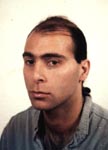 Nitzhi grew up in Holon and began dancing as a 10 year old in school. Inthe army, he took a course for dance leaders with Mishael Barzilai. Hethen became a teacher of folk dance in the army in addition to his mainresponsibility which was producing educational films and special events. Nitzhi starting teaching his first session in Tel Aviv at age 19, while still in the army. Nitzhi grew up in Holon and began dancing as a 10 year old in school. Inthe army, he took a course for dance leaders with Mishael Barzilai. Hethen became a teacher of folk dance in the army in addition to his mainresponsibility which was producing educational films and special events. Nitzhi starting teaching his first session in Tel Aviv at age 19, while still in the army.
After the army, Nitzhi completed the Ulpan L'Madrichim L'Rikuday Am (School for Israeli Folk Dance Leaders). At the same time he taught Israeli folklore through music and dance in a special high school program, in addition to producing educational events. Nitzhi became the main teacher of children's groups in the Holon area and had a dance session practically every night of the week around TelAviv/Holon. where he became a popular leader. By 1995 Nitzhi was appointed a master teacher of Israeli folk dance leaders at the Ulpan L'Madrichim L'Rikuday Am held at Bet Lessing in Tel Aviv and later at the Wingate Institute. While teaching dance full-time he also managed to complete a B,A. in Economics at Ben Gurion University.
Shorashim is Nitzhi's Israeli dance camp debut in the U. S. and he will teach more recent classics as well as a unique workshop focusing on teaching and style similar to what he does at the Ulpan L'Madrichim. |
|
SHMUEL "VICKY" COHEN
|
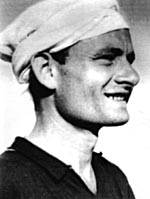 Vicky arrived in Israel in 1948 as a teenager, having spent the World War II years in Hungary, where he was born. He came with a youth group (Hashomer Hatzair) to Kibbutz Mizra, where he first learned to dance the Hora. His dancing career actually began when he served in the army and joined Nachal (Fighting Pioneer Youth). Vicky ended up as a dancer in the Nachal Troupe, which performed at the third Dalia Festival in 1951, under the direction of Yoav and Mira Ashriel. After his army service he joined Kibbutz Harel, and was a member of the dance troupe that represented Israel at the "Democratic Youth Festival" in Bucharest, which won third prize among 100 competing countries. In 1953, Vicky created his first dance - Hora Mamtera, which was the first Israeli Hora to incorporate turns, which were not that acceptable at the time. In 1955, Vicky settled in Kibbutz Dalia and remained there ever since. His debka creations were influenced by the dances of the neighboring Druse villages. Vicky arrived in Israel in 1948 as a teenager, having spent the World War II years in Hungary, where he was born. He came with a youth group (Hashomer Hatzair) to Kibbutz Mizra, where he first learned to dance the Hora. His dancing career actually began when he served in the army and joined Nachal (Fighting Pioneer Youth). Vicky ended up as a dancer in the Nachal Troupe, which performed at the third Dalia Festival in 1951, under the direction of Yoav and Mira Ashriel. After his army service he joined Kibbutz Harel, and was a member of the dance troupe that represented Israel at the "Democratic Youth Festival" in Bucharest, which won third prize among 100 competing countries. In 1953, Vicky created his first dance - Hora Mamtera, which was the first Israeli Hora to incorporate turns, which were not that acceptable at the time. In 1955, Vicky settled in Kibbutz Dalia and remained there ever since. His debka creations were influenced by the dances of the neighboring Druse villages.
Gurit Kadman dubbed Vicky the "Debka King of Israel" for his Debka Chamor, Dalia, Druze, Halel, Katzir & K'agadat Rivka. Many of his dances were created to music and lyrics by Emanuel Zamir. After Zamir's premature death in an auto accident, Vicky's interest in creating new dances waned.
Vicky's participation as the guest choreographer at Shorshim 2001 is his first return to the U. S. since being the guest choreographer at Camp Blue Star in 1983.
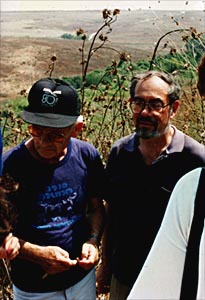 |
Vicky Cohen and Haim Kaufman at the amphitheater where the Dalia festivals took place |
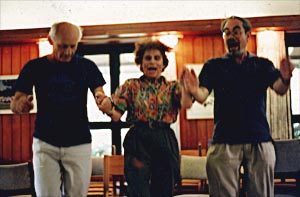 |
Vicky Cohen demonstrating Ka'agadat Rivka with Ayalah Goren Kadman and Haim Kaufman at Kibbutz Dalia |
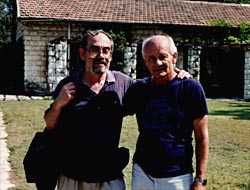 |
Vicky Cohen with Haim Kaufman at the site of the original 1944 festival at Kibbutz Dalia, where the Israeli folkdance movement started |
|
|
AYALAH GOREN-KADMAN
|
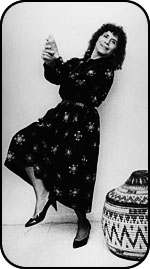 Ayalah Goren-Kadman is one of the foremost teachers, choreographers and researchers of Israeli folk and ethnic dance. Ayalah literally began dancing in the womb, since her mother, Gurit Kadman, is considered the mother of the Israeli folk dance movement. Ayalah Goren-Kadman is one of the foremost teachers, choreographers and researchers of Israeli folk and ethnic dance. Ayalah literally began dancing in the womb, since her mother, Gurit Kadman, is considered the mother of the Israeli folk dance movement.
Ayalah danced in and choreographed for the famous Dalia DanceFestivals, directed the Institute for Folk Dance Leaders in Jerusalem (1966-1975), headed the folklore department of the International Cultural Center for Youth in Jerusalem (1979-1994). In this capacity, She directed the annual regional and national festivals for the performing arts. She also served as consultant for Israel radio and television, the Ministry of Education and Culture and was chairperson of the Dance Committee of the Tel Aviv Foundation for the Arts. In 1987, she established the ethnic dance program of the Rubin Academy of Music and Dance in Jerusalem and continues to direct it.
A graduate of the Hebrew University in anthropology, folklore and theater, Ayalah is a founder of the Israel Ethnic Dance Project which was established in 1972. In this capacity, she has undertaken extensive field work among the ethnic communities of Israel including the Arab sector. She has developed programs for the retention and revival of the folk traditions of Israels diverse society. Together with her mother Gurit Kadman, she has collaborated in producing a series of ethnographic films of the traditional dances of Jews from Yemen, Kurdistan, North Africa, India, Ethiopia, and Eastern Europe.
In 1988, the National Foundation for Jewish Culture brought her to the United States for a series of lectures, master classes and workshops. Since then she has returned periodically to the US to lead workshops and to lecture at dance departments at Juilliard, Teachers College of Columbia University, Barnard, City University of New York and others. In addition, she has been invited to present papers at numerous professional dance conferences around the world.
Ayalah has been intimately involved with the annual Shorashim weekends in New York since they began in 1992. We welcome her back again to Shorashim, where she brings her inexhaustible energy to share with us a vast and unique knowledge of the classic folk dances of Israel. |
|



